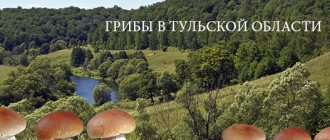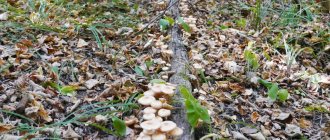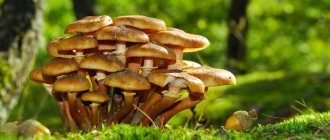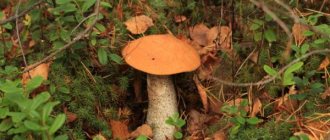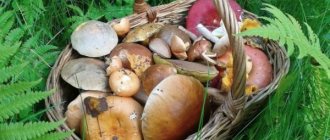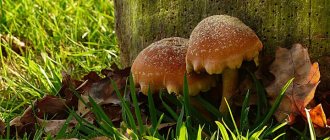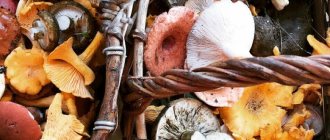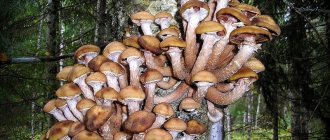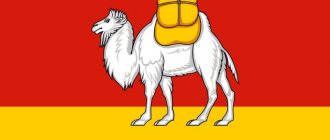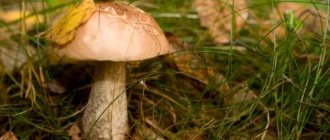Mushrooms
0
1671
Article rating
Kira Stoletova
There are many mushroom places in the Astrakhan region that will delight you with the variety of species found here. The forests of this area bear fruit from spring until late autumn.
Mushrooms of the Astrakhan region
Mushrooms of the Astrakhan region
There are many mushroom places in the Astrakhan region that will delight you with the variety of species found here. The forests of this area bear fruit from spring until late autumn.
- general characteristics
- Classification
- Edible species
- Poisonous species
- Mushroom places
- Benefits and harms
- Benefit
- Harm
- Contraindications
- Conclusion
Mushrooms of the Astrakhan region
general characteristics
Mushrooms of the Astrakhan region include both edible and poisonous species, so you need to know how to distinguish them and what features they have. Each type has certain taste qualities, so mushrooms are prepared in different ways: some are suitable only for pickling, while others are suitable for frying, boiling or freezing.
According to the degree of edibility, mushrooms of the Astrakhan region are divided into 4 categories:
The first two categories are further subdivided into 4 categories based on taste.
Category 1 includes the most delicious and aromatic: porcini mushrooms, saffron milk caps, milk mushrooms.
Category 2 includes white and pink mushrooms, oak mushrooms, boletus mushrooms, forest champignons and Polish mushrooms. Cooks often fry and stew them with seasonings, and then serve them as side dishes.
Category 3 includes chanterelles, moss mushrooms, honey mushrooms, russula and morels, which have a weak aroma, but are no less tasty.
But category 4 is conditionally edible mushrooms, which require pre-processing (soaking and cooking) before the main cooking process. More often they are salted (hot or cold) or marinated with spices. For hot dishes, heat treatment takes at least 1 hour. This group includes flywheels, dung beetles, laticifers, etc.
What to do if you get lost in the forest
- Do not panic!
- If you have a mobile connection, call 112
- If the phone does not work, then you need to listen to the noise: in quiet times, the noise of a tractor can be heard 3-4 km away, a running train 10 km away, a dog barking 2-3 km away, loud screams 1 km away, car horns 2-3 km away, the sound of an ax and the noise of a motorcycle 500 meters away.
- Rescuers from the Ministry of Emergency Situations recommend paying attention to landmarks before entering the forest: which side the sun is on, which direction the river flows. For example, if when entering the forest the sun shines in your face, then when you exit it should be behind you. An even more reliable landmark is a river or stream - when entering the forest, pay attention to which direction the water flows and, if you get lost, go out in the opposite direction to the flow.
- If you realize that you are circling in one place, don’t worry. This is called the “right leg trick”, people always have one step shorter than the other, so you will definitely skid to the side.
Always take matches or a lighter with you!
Classification
They go on a “quiet hunt” with the onset of warm weather, but especially large harvests occur in the fall, when the air is still warm, but already saturated with moisture.
There are more than 100 species of mushrooms in Astrakhan.
Edible species
Among the edible mushrooms growing under last year's leaves in Astrakhan are:
- morels;
- lines;
- tabular champignons;
- birch sponges.
Sponges are rare - they are one of the few types of edible polypores. You can find them in the place of fallen trees. Champignons grow throughout the season, from spring to late autumn. The tabular champignon sometimes reaches enormous sizes. He has an unusual hat, by which he is easily recognizable. It shows patterns in the shape of squares, pyramids or diamonds, which is what gave it its name.
Mushrooms love moisture
In summer, other types are added to them:
- loading;
- chanterelles;
- milk mushrooms white and black;
- tinder fungi;
- waves;
- oyster mushrooms
The following species are collected in autumn:
- honey mushrooms;
- poplars;
- valui;
- boletus;
- rows;
- violins.
Valuy and milk mushrooms are often found in forest plantations. In mushroom areas in the north of the region, oak trees are occasionally found. Honey mushrooms grow before the onset of cold weather. Honey fungus and meadow champignon are found in open forest edges. These are the most common edible species in the area.
Poisonous species
To avoid unpleasant consequences, precautions must be taken. Ingestion of poison into the body leads to poisoning, often with death.
The following species are poisonous:
- satanic mushroom;
- yellow-skinned champignon (yellowish or reddish);
- fly agaric;
- death cap;
- row (talker);
- lepiots;
- fiber.
The outwardly attractive appearance of the fly agaric is misleading. It’s better not to pick it up at all. Some species are so toxic that their poison is absorbed into the skin and penetrates the blood, after which severe poisoning occurs.
Irina Selyutina (Biologist):
The fly agaric is an extremely rare exception among the known poisonous species - it has a pleasant aroma and a rather attractive taste. Therefore, it very often happens that small children (and often not small ones), attracted by these qualities, evading the “intrusive” control of adults, can try this forest curiosity. Therefore, before going into the forest, you should talk to your children and warn them about possible danger. Muscarine is a toxin that is part of the fly agaric and acts like a drug. After consuming it, about 0.5-2 hours later, severe vomiting begins, saliva and sweat occur profusely, and pain appears in the abdominal area. Breathing becomes hoarse and phlegm begins to be released. Very often these manifestations are accompanied by delusions and hallucinations, and in especially severe cases, convulsions occur and the person may lose consciousness. Therefore, the help of a qualified physician is necessary.
Use
The pulp of valueu has a rather unpleasant taste when raw. So much so that in the West the mushroom is considered inedible. In Russia, they make salty preparations from it for the winter, soaking it for a long time beforehand to remove the bitterness from the fruiting body. In Ukraine and Belarus, mushroom caviar from Valueu is very popular.
In general, the process of preparing value is as follows:
- First of all, the fruiting bodies are thoroughly washed from soil, leaves and other debris, after which the bitter skin is carefully removed from them.
- The next step is to soak the mushrooms. This is necessary in order to remove unpleasant odor and bitterness. It takes an average of 2-4 days to soak, using cold water. The liquid is changed twice a day to prevent the mushrooms from turning sour.
- The soaking procedure can be replaced by cooking - heat treatment can significantly reduce the time it takes to prepare the crop for pickling. To do this, the washed fruiting bodies are placed in a pan and filled to the top with water. Cook the mushrooms for at least 40 minutes, after which they can be used for winter preparations.
This species is not suitable for drying, as its pulp is too bitter. It is also not recommended to use legs for blanks; usually only the caps are selected.
Important! Under no circumstances should valui be consumed raw. This prohibition is explained not only by the unpleasant taste, but also by the high content of caustic milky juice in the pulp of the mushroom. In large quantities it poses a serious danger to human health.
Mushroom places
Enotaevsky district is rich in mushrooms
For quiet hunting, mushroom pickers prefer the Volga-Akhtuba floodplain, where many different types of mushrooms grow.
- Enotaevsky district: considered one of the best places. Behind the village of Zamiany there is a huge forest with many mushroom spots. In the spring it is flooded, the soil is saturated with moisture and retains it on hot summer days, which is why there are so many mushrooms there throughout the season. On tree trunks, mushroom pickers encounter oyster mushrooms and sulfur-yellow tinder fungi.
At the end of May, bright polypores appear, which are considered conditionally edible, but if properly processed they are pickled and salted. Fried mushrooms taste like chicken meat.
- Rycha River: along its bed, mushroom pickers collect champignons throughout the season. Getting there is easy along the main Astrakhan-Krasny Yar highway.
The unusual-looking mushroom “titmouse” (dirty row) is found on forest outskirts. Its description indicates a fabulous lilac-lilac color. Some consider it poisonous and destroy the mycelium by tearing the mushrooms out of the ground, which is called “by the roots.” But when properly prepared, “titmouse” turns into a real delicacy and has a pleasant exotic taste.
- Ikryaninsky district, Erik Nozhovsky: this is another good area for picking mushrooms. In its forests, under mulberry (mulberry) trees, many champignons and honey mushrooms are found.
Precautionary measures.
It should be noted that such popularity of the mushroom as in Russia and neighboring countries of the post-Soviet space is not shared in Western countries - there it is considered inedible and mushroom pickers avoid it in the forests. In fact, the valui mushroom can be eaten, but only the youngest specimens should be selected for cooking. In addition, it is not recommended to collect mushrooms that grow in polluted, environmentally unfavorable areas, as they quickly absorb toxins from the soil and can then cause poisoning.
But these are not all the precautions that mushroom pickers need to remember. The so-called false valui is often found in forests. This is a poisonous mushroom that can seriously harm human health. The scientific name of this dangerous mushroom is Hebeloma adhesive. The first difference between the dangerous double is its pungent odor, similar to the aroma of bitter radish. The second difference is the presence of scales on the cap. This dangerous mushroom does not grow and bear fruit for long - only in the autumn months, it is found exclusively under deciduous trees and quickly turns gray when cut, emitting an unpleasant odor.
Benefits and harms
All mushrooms, without exception, have both beneficial and harmful properties.
Benefit
The main component of forest organisms is water. Mushrooms contain fiber, potassium and calcium, which restore cells in the human body.
A huge amount of amino acids helps prevent kidney disease and relieve urolithiasis, stimulates brain function, improves heart function and stabilizes blood sugar levels.
Dishes containing this ingredient are considered difficult to digest. The stems contain a larger amount of chitin compared to the caps, which slows down the digestive process and, if not prepared correctly, causes putrefactive processes in the digestive system. For people suffering from diseases of the gastrointestinal tract, it is important to observe moderation in eating mushrooms.
Mushrooms of the 4th category are subject to pre-treatment: they are carefully sorted, soaked for 3 hours to several days, so that toxic and bitter substances are completely removed from them and cannot cause harm to health.
What does valui look like?
The cap of a mature fruiting body can reach 7-15 cm in diameter and 3-5 cm in height. It is painted in light brown shades. A characteristic feature is the presence of a small hole in the very center of the cap. The surface of the mushroom is very slippery and sticky to the touch. Despite the fact that in adult specimens the cap is quite flat, in young valui it looks more like an egg, which gradually opens. Radial stripes are clearly visible along the edge of the cap.
The hymenophore plates are long and frequently spaced. They are cream in color, sometimes off-white. A translucent yellowish liquid is released from them, which leaves yellowish-ocher stains on the stem. Over time they darken.
The leg looks quite powerful. It reaches an average height of 6-12 cm, while the diameter of the leg can be 3-4 cm. It resembles a barrel in shape. The structure of the leg is quite dense, but there are also hollow specimens. In old valui they become loose, as an empty space of irregular shape forms inside them. The base of the leg becomes stained over time.
The pulp is quite brittle and fragile. When cut, it is white in color, but quickly darkens and acquires a brownish tint. The raw pulp tastes very bitter and burning, and its smell is also unpleasant. Reviews note that it is somewhat reminiscent of the aroma of spoiled butter.
Mushrooms of the Astrakhan region in 2022: best places and collection season
The 2022 mushroom season promises a bountiful harvest and an early start to harvest. In addition, judging by forecasts from weather forecasters, the collection of forest products will be relevant until late frosts. Among the mushrooms of the Astrakhan region there are both edible and poisonous species, so you need to know how to distinguish them and what features they have. Each type has certain taste qualities, so mushrooms are prepared in different ways: some are suitable only for pickling, while others are suitable for frying, boiling or freezing. We’ll also look at the mushroom places of Astrakhan on the map.
Map of mushroom places
- Enotaevsky district. A good place on the map of mushroom places in Astrakhan, where the most mushrooms grow.
- Zamiany village. Oyster mushrooms and tinder fungi are collected in its vicinity. The large number of mushrooms in this area is due to the presence of several bodies of water. During heavy rainfall, they overflow their banks, flooding the area. When the weather stabilizes, the soil becomes ideal for mushroom growth.
- highway Astrakhan - Krasny Yar. Polypores grow here. They are considered popular because... tastes like chicken meat. Near the Rychana River, champignons bear fruit throughout the season.
Map of the Astrakhan region/
What mushrooms grow in the Astrakhan region
For quiet hunting, mushroom pickers prefer the Volga-Akhtuba floodplain, where many different types of mushrooms grow. Enotaevsky district is considered one of the best places. Behind the village of Zamiany there is a huge forest with many mushroom spots. In the spring it is flooded, the soil is saturated with moisture and retains it on hot summer days, which is why there are so many mushrooms there throughout the season. On tree trunks, mushroom pickers encounter oyster mushrooms and sulfur-yellow tinder fungi.
At the end of May, bright polypores appear, which are considered conditionally edible, but if properly processed they are pickled and salted. Fried mushrooms taste like chicken meat. Along the bed of the Rycha River, mushroom pickers collect champignons throughout the season. Getting there is easy along the main Astrakhan-Krasny Yar highway. The titmouse mushroom, an unusual-looking mushroom, is found on forest outskirts. Its description indicates a fabulous lilac-lilac color. Some consider it poisonous and destroy the mycelium, destroying mycosis. But when properly prepared, titmouse turns into a real delicacy and has a pleasant exotic taste.
Another good area for collecting is Erik Nozhovsky in the Ikryaninsky district. In its forests, under mulberry trees, many champignons and honey mushrooms are found. The most popular Astrakhan mushrooms are probably champignons; there are several types of them in our region, for example, common champignon and field champignon. The main thing is that they all have pink plates under their hats, a pleasant smell - and taste. Perhaps this is self-deception, but harvested champignons always seem much tastier than store-bought ones! Champignons belong to the first category of edible mushrooms; they can be fried, boiled, pickled, and each method has its adherents.
Champignons in the Astrakhan region.
You can find champignons in a wide variety of places, often even far from trees, in short grass, usually in entire clearings, which are sometimes called “witch circles.” The main thing is not to miss the moment when the plates under the mushroom cap darken, it becomes overripe and becomes tasteless. Champignons grow almost all year round, the main thing is rain or heavy fog, but they are not very good in the Astrakhan region, so the main champignon season also occurs in mid-autumn.
Valui, which is actually a row of poplar, is also very popular in the Astrakhan region. As the name suggests, these mushrooms prefer poplar plantings, and are found mainly above Astrakhan, on the islands between the Volga and Akhtuba. Moreover, finding them is quite difficult, especially for non-specialists, because these mushrooms are hidden under the foliage, in the ground, from where they need to be dug up. Mushroom pickers in poplar groves leave characteristic marks similar to wild boar tracks; they usually mean that you are too late, all the mushrooms have already been collected, look elsewhere.
Poplar row is a conditionally edible mushroom; it must be soaked for several days (and first cleared of soil for a long time), changing the water, and only after that can it be pickled or salted. But mushroom hunting lovers are not afraid of this. The poplar row mainly appears in October.
Unbelievable but true! 5 interesting things about Astrakhan flora
If you suddenly hear (once again): “There are no forests in Astrakhan!”, “No trees!” and in general, “We have one continuous steppe,” urgently grab these experts in your arms and go with them out of town. Although in Astrakhan you can also find a lot of interesting vegetation, in some corners of our region it is quite special. Let's give a few examples right now...
Unbelievable but true! – there are forests in the Astrakhan region! Yes, maybe they don’t pretend to be the “pomp” of the middle zone, but they exist and there are a lot of them! Summer will greet you with the freshness of the green forest, autumn with its gold. A striking example of this (in the literal sense of the word) is Erik Nozhovsky in the Ikryaninsky district.
And how can one not remember the famous Paustovsky syllable...
Just imagine: the banks of the reservoir are curved in the shape of a knife, the water surface is calm, trees (poplars, mulberries, wild blackberry bushes) are reflected in it. A light breeze rustles the leaves of the trees - a sound that you want to listen to and listen to. The forest was planted here more than a dozen years ago. As a result, the palisade of trees stretched along the shore in a not wide, but very long strip.
Wild ducks swim in flocks on the water. Fabulously beautiful swans fly up in pairs. Rooks fly overhead. Partridges hide in the thickets of bushes and reeds, near the water. Most likely, if you are not a hunter, you will not notice this bird until it, noticing you, takes off right from under your feet with a loud funny cry.
She was scared of you, so she jumped out of her hiding place to hide.
___________________
Unbelievable but true ! – we have long-lived oaks. The land of Astrakhan is famous not only for the Petrovsky oak! In the area of the Volga-Akhtuba interfluve there is a special forest in which such rare trees for our region as pedunculate oak grow. The majestic tree can reach 50 meters in height, and its age can well exceed a thousand years.
